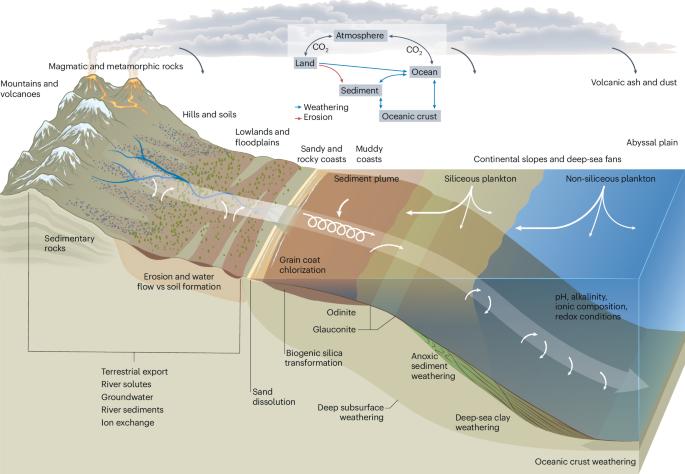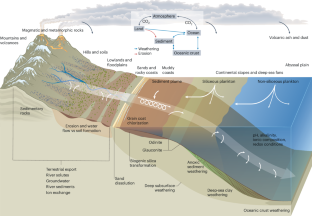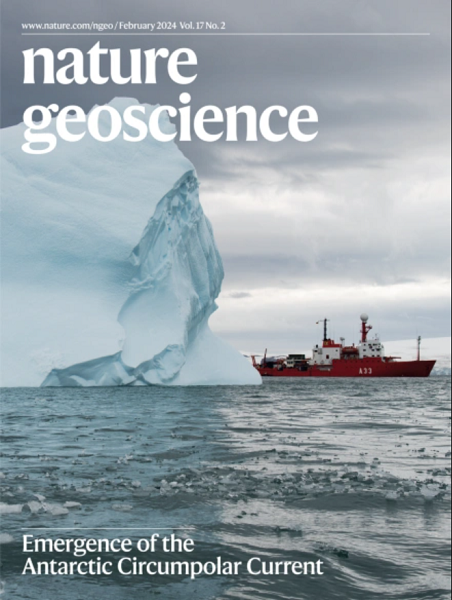Earth’s silicate weathering continuum
IF 16.1
1区 地球科学
Q1 GEOSCIENCES, MULTIDISCIPLINARY
引用次数: 0
Abstract
Chemical weathering of silicate rocks redistributes major, minor and trace elements through coupled dissolution–precipitation reactions. These weathering processes drive shifts in ocean acid–base chemistry, modulating atmospheric carbon dioxide levels and providing a stabilizing feedback in the carbon cycle. Silicate weathering occurs in both terrestrial and marine environments, releasing (‘forward’) or consuming alkalinity (‘reverse’), but these have largely been perceived as independent and studied in isolation. However, weathering products are transported downstream across terrestrial and to marine environments, suggesting a dynamic coupling of these weathering processes across scales. Here we propose that the Earth’s silicate weathering occurs along a continuum linking mountains to the deepest sedimentary environments and forward to reverse weathering. In this framework, the magnitude and direction of a local weathering flux depends on the materials’ origin, weathering–erosion history and environmental conditions. Consequently, global silicate weathering fluxes and the long-term carbon cycle feedback may be governed by the dynamic interplay of various environments along the silicate weathering continuum. Chemical weathering of silicate rocks occurs along a continuum from terrestrial to marine environments.


地球的硅酸盐风化连续体
硅酸盐岩石的化学风化作用通过溶蚀-沉淀耦合反应重新分配主、次、微量元素。这些风化过程驱动了海洋酸碱化学的变化,调节了大气中的二氧化碳水平,并在碳循环中提供了稳定的反馈。硅酸盐风化发生在陆地和海洋环境中,释放(“正向”)或消耗碱度(“反向”),但这些在很大程度上被认为是独立的,并被孤立地研究。然而,风化产物通过陆地和海洋环境向下游输送,表明这些风化过程在不同尺度上存在动态耦合。在这里,我们提出地球的硅酸盐风化发生在一个连续体上,将山脉与最深处的沉积环境联系起来,并向前进行反向风化。在这个框架中,局部风化通量的大小和方向取决于材料的来源、风化侵蚀历史和环境条件。因此,全球硅酸盐风化通量和长期碳循环反馈可能受到沿硅酸盐风化连续体的各种环境的动态相互作用的支配。
本文章由计算机程序翻译,如有差异,请以英文原文为准。
求助全文
约1分钟内获得全文
求助全文
来源期刊

Nature Geoscience
地学-地球科学综合
CiteScore
26.70
自引率
1.60%
发文量
187
审稿时长
3.3 months
期刊介绍:
Nature Geoscience is a monthly interdisciplinary journal that gathers top-tier research spanning Earth Sciences and related fields.
The journal covers all geoscience disciplines, including fieldwork, modeling, and theoretical studies.
Topics include atmospheric science, biogeochemistry, climate science, geobiology, geochemistry, geoinformatics, remote sensing, geology, geomagnetism, paleomagnetism, geomorphology, geophysics, glaciology, hydrology, limnology, mineralogy, oceanography, paleontology, paleoclimatology, paleoceanography, petrology, planetary science, seismology, space physics, tectonics, and volcanology.
Nature Geoscience upholds its commitment to publishing significant, high-quality Earth Sciences research through fair, rapid, and rigorous peer review, overseen by a team of full-time professional editors.
 求助内容:
求助内容: 应助结果提醒方式:
应助结果提醒方式:


